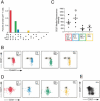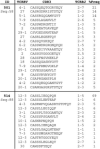Immunisation with BCG and recombinant MVA85A induces long-lasting, polyfunctional Mycobacterium tuberculosis-specific CD4+ memory T lymphocyte populations
- PMID: 17948267
- PMCID: PMC2365909
- DOI: 10.1002/eji.200737504
Immunisation with BCG and recombinant MVA85A induces long-lasting, polyfunctional Mycobacterium tuberculosis-specific CD4+ memory T lymphocyte populations
Erratum in
- Eur J Immunol. 2011 May;41(5):1501
Abstract
In the search for effective vaccines against intracellular pathogens such as HIV, tuberculosis and malaria, recombinant viral vectors are increasingly being used to boost previously primed T cell responses. Published data have shown prime-boost vaccination with BCG-MVA85A (modified vaccinia virus Ankara expressing antigen 85A) to be highly immunogenic in humans as measured by ex vivo IFN-gamma ELISPOT. Here, we used polychromatic flow cytometry to investigate the phenotypic and functional profile of these vaccine-induced Mycobacterium tuberculosis (M.tb) antigen 85A-specific responses in greater detail. Promisingly, antigen 85A-specific CD4(+) T cells were found to be highly polyfunctional, producing IFN-gamma, TNF-alpha, IL-2 and MIP-1beta. Surface staining showed the responding CD4(+) T cells to be relatively immature (CD45RO(+) CD27(int)CD57(-)); this observation was supported by the robust proliferative responses observed following antigenic stimulation. Furthermore, these phenotypic and functional properties were independent of clonotypic composition and epitope specificity, which was maintained through the different phases of the vaccine-induced immune response. Overall, these data strongly support the use of MVA85A in humans as a boosting agent to expand polyfunctional M.tb-specific CD4(+) T cells capable of significant secondary responses.
Figures





References
-
- Frieden TR, Sterling TR, Munsiff SS, Watt CJ, Dye C. Tuberculosis. Lancet. 2003;362:887–899. - PubMed
-
- Cahn P, Perez H, Ben G, Ochoa C. Tuberculosis and HIV: a partnership against the most vulnerable. J. Int. Assoc. Physicians AIDS Care (Chic Ill) 2003;2:106–123. - PubMed
-
- Espinal MA, Kim SJ, Suarez PG, Kam KM, Khomenko AG, Migliori GB, Baez J, et al. Standard short-course chemotherapy for drug-resistant tuberculosis: treatment outcomes in 6 countries. JAMA. 2000;283:2537–2545. - PubMed
-
- Trunz BB, Fine P, Dye C. Effect of BCG vaccination on childhood tuberculous meningitis and miliary tuberculosis worldwide: a meta-analysis and assessment of cost-effectiveness. Lancet. 2006;367:1173–1180. - PubMed
-
- Fine PE. Variation in protection by BCG: implications of and for heterologous immunity. Lancet. 1995;346:1339–1345. - PubMed
Publication types
MeSH terms
Substances
Grants and funding
LinkOut - more resources
Full Text Sources
Other Literature Sources
Medical
Research Materials

